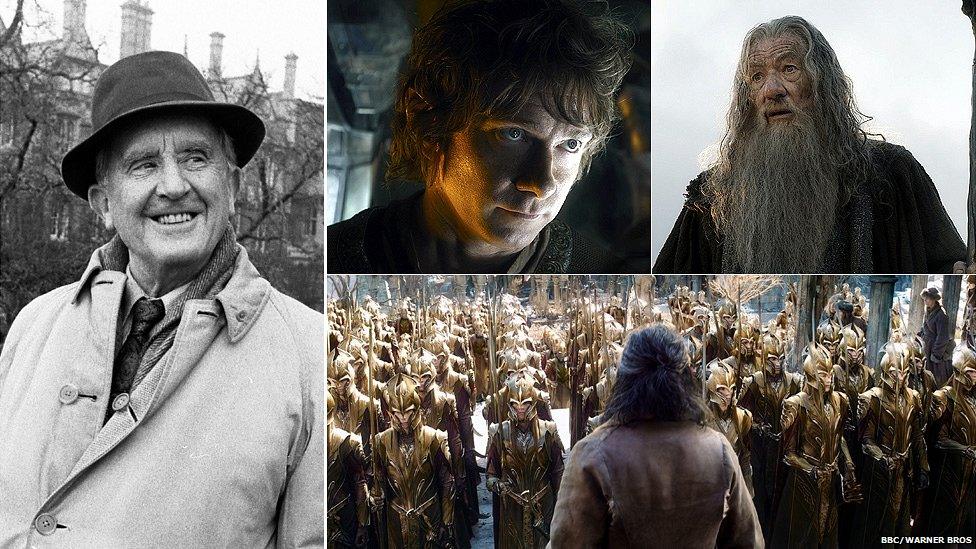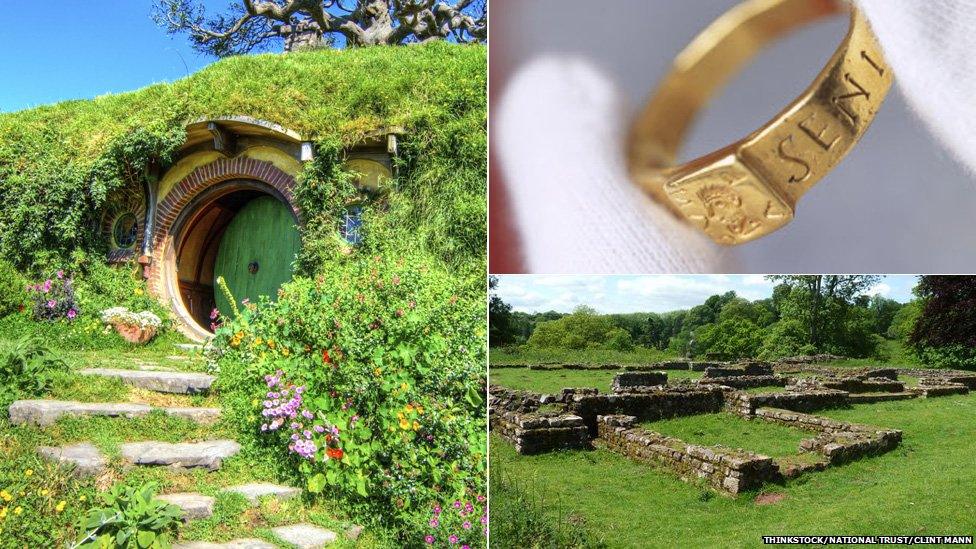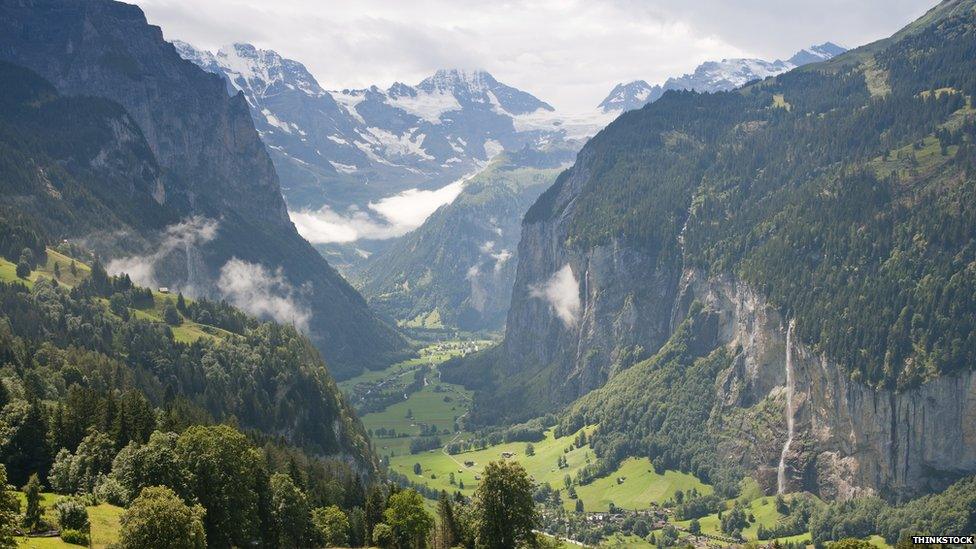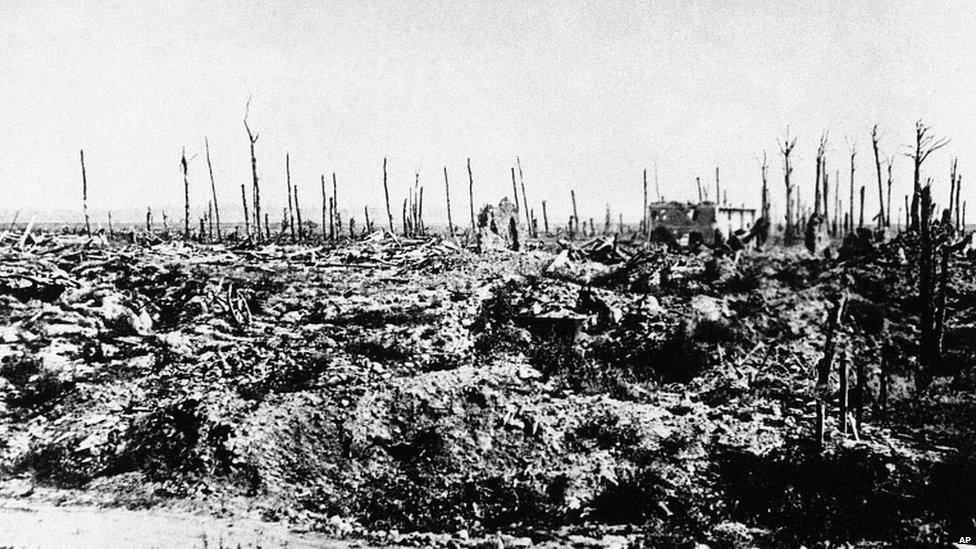The Hobbit: How England inspired Tolkien's Middle Earth
- Published

JRR Tolkien (left) wrote The Hobbit during the 1930s when he was a professor at Oxford University
Small hairy feet will be back on screen again as The Hobbit: The Battle of the Five Armies marches into cinemas worldwide next week. While the film trilogy, along with the previous Lord of the Rings adaptation, were shot in New Zealand, the books' author JRR Tolkien drew inspiration mainly from the English landscape.
So which locations are behind the fictional Middle Earth?

The Shire
.jpg)
Tolkien described the area around Sarehole Mill, still in operation, as "a kind of lost paradise"
In a letter to his publishers, John Ronald Reuel Tolkien wrote that The Shire - home to the "little people" better known as hobbits - was "more or less a Warwickshire village of about the period of [Queen Victoria's] Diamond Jubilee" in 1897.
Although born in South Africa in 1892, Tolkien moved to England at the age of four with his mother and brother after the death of his father. They lived in and around Birmingham, including at the village of Sarehole, which, like the fictional Hobbiton, had a corn-grinding mill by the water.
In a newspaper interview Tolkien fondly recalled the area, saying the Shire was "inspired by a few cherished square miles of actual countryside at Sarehole".
However, while the mill is still standing, the area is now surrounded by Birmingham's suburbs.

Hobbit holes and The Ring

Tolkien's vision of the hobbit holes was recreated for Peter Jackson's films but some say the author may have also been influenced by a Roman ring and the Lydney Park ruins
As for the hobbits' homes and their eye-catching round doors, some people claim they were based on ruins at Lydney Park, in Gloucestershire.
In 1929, Tolkien, then a professor of Anglo-Saxon at Oxford University, visited an archaeological dig at the estate on the site of a Roman temple, known as Dwarf's Hill.
It is thought that he was then told about an inscribed gold ring found in a Hampshire field in 1785, also linked to a Roman curse tablet discovered at Dwarf's Hill. Tolkien is believed to have started writing The Hobbit, about a Halfling who finds a cursed ring, a year later.
"There's a lot of nice associations to it for Tolkien fans," says Mathew Lyons, author of There and Back Again: In the Footsteps of J.R.R. Tolkien.
"There are these holes down there, which the local tradition says used to be lived in by little people [but] Tolkien didn't explicitly make that connection."

Rohan and Gondor

Tolkien compared parts of the Malvern Hills with the White Mountains between Rohan and Gondor
There is debate over whether the horse-riders of Rohan are based on the Anglo-Saxons. Tolkien wrote the characters did not resemble "the ancient English... except in a general way due to their circumstances; a simpler and more primitive people living in contact with a higher and more venerable culture".
Despite this, many academics link Rohan to one of the most powerful kingdoms of Anglo-Saxon England - Mercia, which was based in the Midlands where Tolkien spent much of his youth. Some also say the riders' names are rooted in the Mercian dialect.
"Tolkien identified at quite an emotional level with Mercia, and West Mercia in particular, and the language, and he put a lot of that into Rohan," says Mr Lyons.
George Sayer, who wrote the biography of CS Lewis, remembered hiking with Tolkien in the Malvern Hills in Worcestershire.
The Lord of the Rings author "lived the book as we walked, sometimes comparing parts of the hills with, for instance, the White Mountains" that marked the border between Rohan and Gondor, he said.
Following an Italian holiday in 1955, Tolkien, somewhat light-heartedly, referred to Venice as Gondor. However, this was after he had written Lord of the Rings. He also wrote that Gondor's power to build "the gigantic and massive" resembled the ancient Egyptians.

The Two (and more) Towers

As a boy growing up in Birmingham, Tolkien would have been familiar with Edgbaston Waterworks, Perrott's Folly and the university clock tower
Tolkien wrote Lord of the Rings as a single epic but, due to its length, his publishers printed it in three volumes, naming the second book The Two Towers - a title of which the author wrote he was "not at all happy".
He wrote that it could be linked to the tower of Orthanc [the home of the wizard Saruman] and the "Tower of Cirith Ungol" - a fortress of the dark lord Sauron - but said this was misleading as the story also prominently featured two other towers, Minas Tirith - the capital of Gondor - and the Dark Tower, Sauron's main base.
Many believe the towers were modelled on Perrott's Folly and the Waterworks Tower in the Birmingham suburb of Edgbaston, where Tolkien lived as a boy.
In addition, the illuminated clock tower at the University of Birmingham, visible across the city, has been suggested as the inspiration for the ever-watchful "Eye of Sauron".

Rivendell

Tolkien had his own adventures, including at Lauterbrunnen Valley in the Swiss Alps
In a letter to his son Michael, the author wrote that Bilbo Baggins' journey from the Elvish settlement of Rivendell to the Misty Mountains was based on a 1911 trip to Switzerland.
"We went on foot carrying great packs practically all the way from Interlaken, mainly by mountain paths, to Lauterbrunnen and so to Mürren and eventually to the head of Lauterbrunnenthal in a wilderness of morains," he recalled.
Barring the Elves' residence, Tolkien's drawing of Rivendell in the illustrated edition of The Hobbit is almost identical to a view of Lauterbrunnen Valley.

Dead Marshes

Tolkien arrived at the French battlefields of World War One in June 1916
Although Tolkien fought in World War One, he said the two world wars had not inspired the writing of The Hobbit and Lord of the Rings.
However, he did admit the landscape of the Dead Marshes, where Frodo Baggins is transfixed by corpses lying in pools, and the approach to Mordor's Black Gate "owe something to Northern France after the Battle of the Somme".
But, as Tolkien wrote in the foreword to the second edition of Lord of the Rings: "An author cannot of course remain wholly unaffected by his experience, but the ways in which a story-germ uses the soil of experience are extremely complex, and attempts to define the process are at best guesses from evidence that is inadequate and ambiguous."